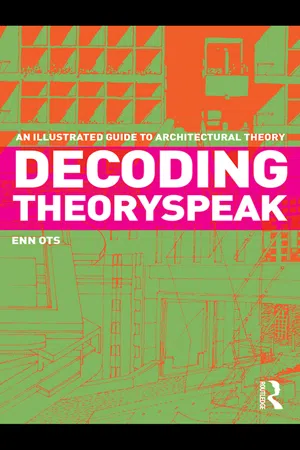
- 240 pages
- English
- ePUB (mobile friendly)
- Available on iOS & Android
eBook - ePub
About this book
Existentialism; Urbanism; Aporia; Deontic; Tabula Rasa; Hyperspace; Heterotopia; Metareality; Structuralism…
What does it all mean?
The unique language used in architectural theory – both in speech and writing – can appear daunting and confusing, particularly to new architectural students.
Decoding Theoryspeak provides an accessible guide to the specialized language of contemporary design for the next generation of thinkers, architects and design leaders. It includes:
- definitions of over 200 terms
- clear cross-references
- illustrations throughout.
It is an essential pocket-sized resource for students and practitioners alike.
Frequently asked questions
Yes, you can cancel anytime from the Subscription tab in your account settings on the Perlego website. Your subscription will stay active until the end of your current billing period. Learn how to cancel your subscription.
At the moment all of our mobile-responsive ePub books are available to download via the app. Most of our PDFs are also available to download and we're working on making the final remaining ones downloadable now. Learn more here.
Perlego offers two plans: Essential and Complete
- Essential is ideal for learners and professionals who enjoy exploring a wide range of subjects. Access the Essential Library with 800,000+ trusted titles and best-sellers across business, personal growth, and the humanities. Includes unlimited reading time and Standard Read Aloud voice.
- Complete: Perfect for advanced learners and researchers needing full, unrestricted access. Unlock 1.4M+ books across hundreds of subjects, including academic and specialized titles. The Complete Plan also includes advanced features like Premium Read Aloud and Research Assistant.
We are an online textbook subscription service, where you can get access to an entire online library for less than the price of a single book per month. With over 1 million books across 1000+ topics, we’ve got you covered! Learn more here.
Look out for the read-aloud symbol on your next book to see if you can listen to it. The read-aloud tool reads text aloud for you, highlighting the text as it is being read. You can pause it, speed it up and slow it down. Learn more here.
Yes! You can use the Perlego app on both iOS or Android devices to read anytime, anywhere — even offline. Perfect for commutes or when you’re on the go.
Please note we cannot support devices running on iOS 13 and Android 7 or earlier. Learn more about using the app.
Please note we cannot support devices running on iOS 13 and Android 7 or earlier. Learn more about using the app.
Yes, you can access Decoding Theoryspeak by Enn Ots in PDF and/or ePUB format, as well as other popular books in Architecture & Architecture General. We have over one million books available in our catalogue for you to explore.
Information
Absence/presence
When Structuralists and Post-Structuralists make the apparently outrageous claim that every object is both a presence and an absence, they mean that an object is never fully there – it is there to the extent that it appears before us, but is not there in so far as its being is determined by its relation to the whole system of which it is part, a system that does not appear to us. — Donald Palmer
There is no presence. There is no absence. There is only the difference between them, always and already in movement. — Michael Benedikt
The notion that a work of architecture can have a simultaneous quality of absence and presence is part of the late twentieth century Structuralist effort at placing designed objects within their larger contexts. For them, the quality of absence was relative to our unconscious understanding of the missing. The quality of presence was simply what we have before us, no more. The discipline for understanding these notions was borrowed from linguistics, a well-developed philosophical science, having been initiated by de Saussure in the first decade of the twentieth century. The qualities of absence and presence are not only significant to the Structuralists. Phenomenologists have an interest in the presentness of the object, devoid of the absence. What matters most to them is the raw reality of the experience of the object before them. In other words, the immediate presence of the object is what is truly real.
A building with presence, with a kind of mute awareness of its doors left ajar and windows open, finally seems attentive to our presence. — Michael Benedikt
Post-modern style architects confronted absence by overtly sampling architectural artifacts from the past. The intent was to restore meaning to a mute modern architecture. This attempt at the removal of the absence, by being more evident and literal may have been one of the downfalls of post-modern architecture, particularly as practiced by less talented second-tier designers. The deconstructivist architecture that briefly followed the post-modern architectural style abandoned all references to the implicit structures that form the absence. What were being “deconstructed” were the underlying artificial structural constructs that Structuralists contended formed the absence. In the twenty-first century the project of post-deconstructivism has been to rediscover the absent structures that fall within the agenda of critical theory. Socio-political and economic contexts are once again acknowledged. In a twist of fate, the current digital blob and fold advocates seem to be most interested in an aggressive presence at the expense of absence. Their references to context are typically missing. This is illustrated by the Grande Arche at

Figure 1: La Grande Arche, Paris
La Defense in Paris, which has a strong presence due to the absence of context, and even the middle of the building itself (Figure 1).
Space – The presence of absence. — Bernard Tschumi
See also: Critical theory • Deconstructivism (Archispeak) • Emptiness • Silence • Structuralism.
Abstraction
According to Plato, words name concepts, ideas, which are abstractions. — Donald Palmer
Modern architecture attempted to strip itself of the outward trappings of “Classical” style. This process of reduction was called abstraction. — Peter Eisenman
Modern architecture employed many forms of abstraction, including the elevation of function to the status of form giver. As illustrated in Figure 2, abstraction in modern architecture can even reduce the building to its bare bones. To abstract is a fundamental human need. Abstraction allows one to confront the complexities of raw reality through a process of sorting, labeling, cataloguing, and denying those aspects of our world that do not fit the invented schema. Newtonian space is a powerful abstraction that relates directly to classical and modernist architecture, just as the abstraction we call non-Euclidean space can be regarded as one of the hallmarks of twenty-first century architecture. An interesting twist to contemporary architectural form abstractions is the use of the folds, twists, and blobs derived from nature. Architecture has moved from the simplistic notion of “form follows function” of modern architecture to an even greater level of abstraction. “Form” is no longer the primary concern of a meaningful and ethical green digital architecture. “Function” is declared a dead end, as it has proven to be too transitory and arbitrary.
Ironically, the growing use of digital media has made it possible to cyber simulate the visible world with less abstraction. The virtual world is becoming more real with each new massive multiplayer online game. The digital design process, however, has abstracted the physical act of design. The designer no longer has an intimate relationship with her design media. It is housed in the virtual world, which she can only observe through the looking glass. Occasionally, in response to the client’s need for a physical manifestation of the design, traditional physical models are still produced. With the use of rapid prototyping machines, even these physical models are produced without the intimate involvement of the designer. Physical models are still favored by many clients, even though they are more abstract than a fully rendered digital model. For group viewing situations, physical models are in the round and thus easier to use for fund raising and general promotional purposes.
See also: Abstraction • Blob architecture (Archispeak) • Blobitecture • Digital architecture • Fold • Form • Prototyping
Further sources: Ballantyne (2002: 34); Colebrook (2006: 99); Gausa (2003: 21, 24) Johnson (1994: 331) Lefebvre (in Hays: 174)

Figure 2: Franklin Court:
Accident
I hate perfection. I think perfection is boring. Instead, there is something beautiful about accident, when things never completely fit. — Winka Dubbeldam
Many of the world’s most important discoveries have been made as a consequence of what is often termed the “happy accident.” Examples are Johann Aloys Senefelder’s discovery of the lithographic printing process in 1798 after accidentally spilling bacon fat on to a stone surface, the Victorian William Henry Perkins stumbling upon mauve, the first aniline dye, when attempting to create artificial quinine in the 1860s, and among the most famous, Isaac Newton’s observation of an apple falling from a tree which led to his musings on the nature of gravity. Indeed, accidents have led to the discovery of countless innovations both great and small, from the chocolate chip cookie and the Post-It note to penicillin, ink jet printers, and polycarbonates. The amount of discoveries due to accident varies extensively across the disciplines – pharmacology and chemistry probably represent the fields where such serendipitous discoveries occur more frequently.
History, of course, does not document accidental exposures of information, which could have resulted in a new discovery, and we are justified in suspecting that they are many. However, one aspect of such discoveries is that their discoverers agree upon one common point of view. That is, while prejudice and preformed concepts present the greatest obstacle, a receptively open mind is required on the part of the inventor or scientist to detect the importance of information that is suddenly and accidentally revealed.
While examples abound in art, accident can also play a key role in architecture, where some designers purposefully employ misadventure as part of their design process. Perhaps the most vivid architectural example can be found in Bernard Tschumi’s competition-winning design for the Parc de la Villette in Paris (see Figure 3). Here, Tschumi used serendipitous techniques to superimpose point, line, and field, each planned to have “accidental” intersections. As each layer was supposedly developed without regard for the others, the results are surprisingly productive. Will Alsop is another architect who, unusually, arriving at his architectural designs via painting, is constantly open to the incidence of accident and chance. He describes a stain on a drawing accidentally left behind by a wine glass as having the potential...
Table of contents
- Contents
- Illustrations
- List of contributors
- Acknowledgements
- Preface
- Introduction
- Theoryspeak
- List of terms
- Further reading